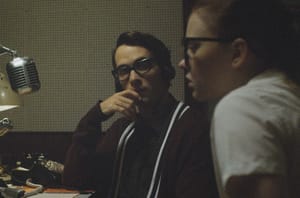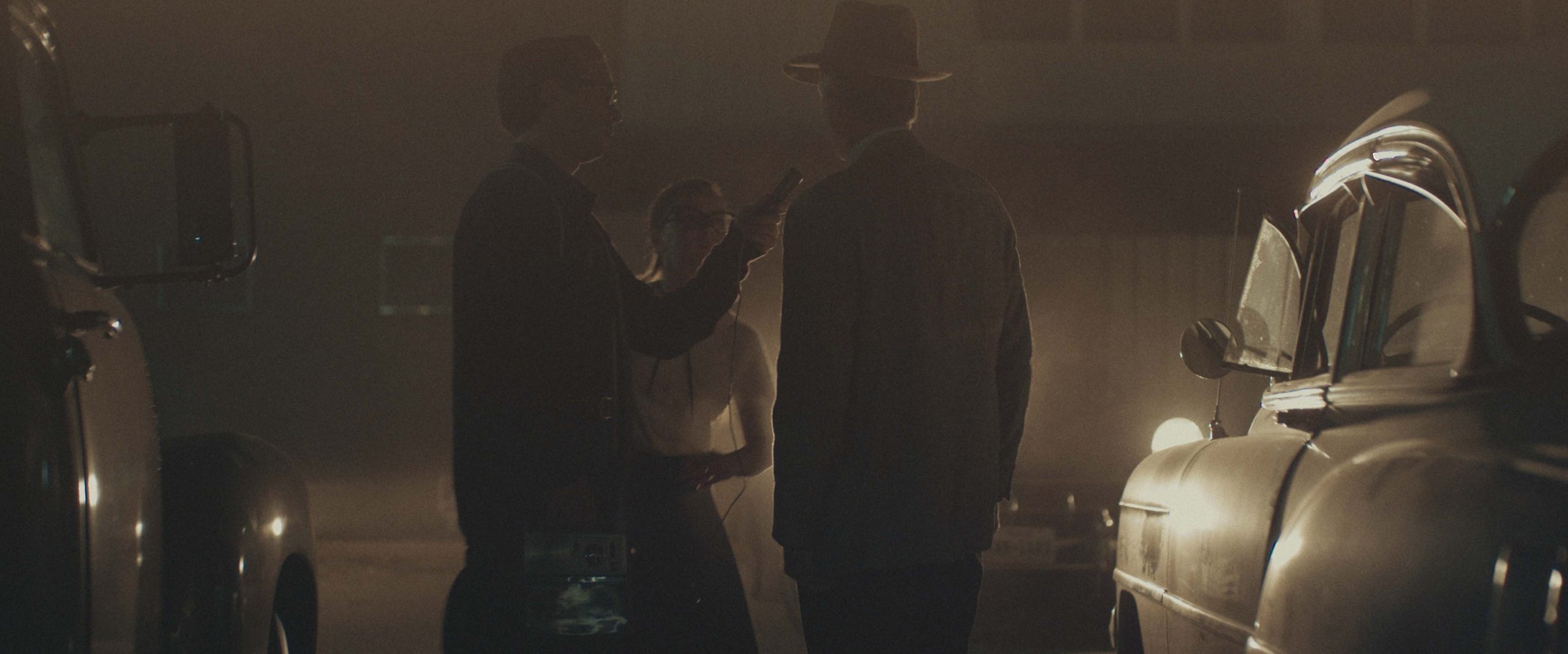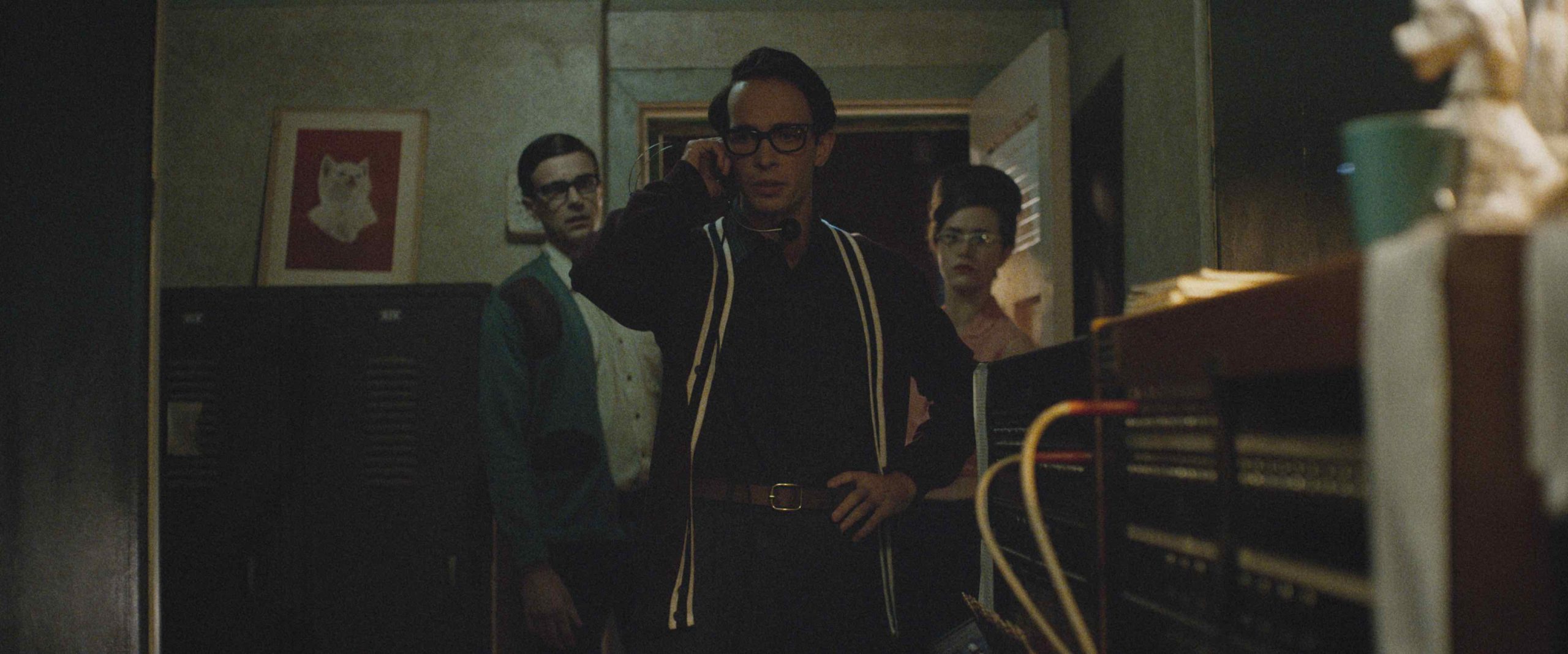
Andrew Patterson is a director, producer, and screenwriter. In this piece, he talks about the making of his throwback thriller The Vast of Night, which is now streaming.
The genesis for The Vast of Night was that I had a list of ideas from probably the last 10 years, and one just said: “1950s black and white. New Mexico, UFO landing.” The only thing I had to ditch was making it black and white, but there was nothing else to it; there was no other meat behind that. From there, we started working on fleshing it out, building it into a full script and actually making it into something that was potentially going to stand out in the cinematic landscape — which is hard to know how to do. We decided to crawl into some really bold choices about how to use sound and when to turn off visuals and leave the screen black, and when to let people tell long stories, and try to build something new from that.
The hardest part of the screenwriting process was trying to build a dynamic with the two lead characters. That easily took two thirds of the time it took to write this script. Interestingly enough, the genders swapped a couple of times in the process. At one point the character of Everett (Jake Horowitz), a radio DJ, was introverted and shy, and the character of Fay (Sierra McCormick) was extremely vivacious — she was the one grabbing the microphone and running around interviewing local people. We found that felt a little forced for this movie, and we also wanted an arc for the character of Fay, where she starts out kind of quiet and in the background, and has sort of an Ellen Ripley arc where she takes the lead by the end of the movie.
It took a long time to figure out that first act of the movie. It ended up being 18-20 minutes in the movie, but on the page, it gets twice as many pages — it’s about 35-36 pages of Fay and Everett getting to know each other, walking through the street, interviewing people and getting to their jobs. That was what we wanted to feel super fresh and new in cinema, so much so that you would be along for the next two acts, no matter what happened.
Shooting that opening with Everett and Fay was scattered all throughout the shoot. On an indie movie, you don’t get any breaks at all. Everything we shot in a key parking lot scene was in one evening, because we had to utilize our period- accurate cars. There were only about 12 to 15 of them, and they kept disappearing over the course of the evening. People think it’s going to be real fun to shoot a movie, until it gets to be 2 a.m., and you’re only halfway through your day. So as the cars disappeared, we had to block things differently. Then there are scenes where they’re walking and talking and she’s telling a story. Those were tacked onto a night that we would shoot something else.

This method of shooting is convenient until you have to light every square inch of the space that you’re jumping into. There’s no sunlight, so if we decided, hey, we need to do this, we got two hours before the sun rises, so let’s tack this scene on, we would have known that this was a possibility going into that night. Usually our grip and electric guys would have run ahead and lit that space for us. Then if we got to it, great, and if we didn’t, we would have to bump it to another night. We couldn’t even use the practical lights because they’re the wrong color. Most city street lighting now is sodium vapor, which is orange, and mercury vapor would have been what was out there in the ’50s. I was obsessed with the idea that if you do your job right, as a writer, you don’t have to cut very much. If you’re telling stories that are fascinating, you don’t actually need the assistance of editing. And I believe that cinema bears that to be true; great plays prove that. So it was never going to be a heavily cut movie. There are around 700 shots in The Vast of Night: Some are as long as 10 minutes, and obviously some are as short as a few frames. The average movie sits at about 1,800 shots. So we’re about one third of the cutting rhythm of your average movie. The actual reason behind that has to do with the fact that editing dates movie pretty quickly. When you cut, how you cut, how you cut over music, that’s what dates movies the most. The movies that look the most undated — Dog Day Afternoon, Lawrence of Arabia, All the President’s Men — only cut when they have to. That was always the way we were going to shoot it.
Also read: Introducing Demystified – All the Answers About How to Sell Your Film
I like the restrictions of movies like To Kill a Mockingbird. You can see how they have to use the same five or six locations they’re using in every movie within that window of time. The town square that they use in Inherit the Wind, Bye Bye Birdie, to Back to the Future. We mimicked that in our movie so that it would look like we had this Twilight Zone-esque TV show feel, like it was being shot on the backlot of Hollywood 50 years ago.
People would go, now wait a minute, that’s not what houses look like in southern New Mexico — we know. It’s not what houses look like in Mississippi; it’s not what houses look like in West Virginia; it’s not what houses look like in Indiana. But if you watched the movies between like 1945 and 1965, they all look like that. Hitchcock movies look a whole lot like other movies from that era because they were all using the same sets. We wanted our movie to look like we were stuck with those limitations.
I always want the actor to come into a scene with a preferred approach, and then we work together for it to become something more than they could have reached on their own, ideally— otherwise, why do they need a director? The worst idea is to make them feel like what they brought was wrong — it’s not quite wrong, ever. Can I find something that’s closer to a realistic experience the character would be having right here? And so yes, sometimes the first approach by the actor would be off, and I would let them have a handful of those takes, and then you know that you want to get the actor from A to Z. You don’t do that by giving them 16 characters of the alphabet to get halfway there. You give them one, and then you give them another two, maybe. And then over the course of maybe eight or nine takes, there is Z, without them even necessarily realizing how we got them there. I think visually: If they’re on a low note on the piano, and you want them on a high note? You move them up slowly. It’s a dynamic that we’re working through together.

The way we were able to craft the performances to where I was super pleased with them was by not having extra coverage. There was one scene that was six pages that I shot in 15 seconds. And I remember my DP understanding, “OK, now I see how we’re going to get through this movie.” It’s the scene where four characters descend on the middle of town, all at once, and they all talk on top of each other — that’s six pages. I cared more about the tone of what was happening in that moment in the narrative than I did about each character getting their turn with their own close up and reverse shot which would have taken a whole night to shoot — it would have taken 12 hours. So how I got around some of the limitations that indie movies have was, “Okay, how do we do this? How do we prep this in a way that lets me have a one shot I want, rather than the one shot plus 10 others, so that I can form this movie and edit it out in post.” In this case if we decided to get all that extra coverage, we just wouldn’t have made our night, and therefore we couldn’t have had our movie.
We blocked more, we prepped more, and above all we cast the right people. All of the actors were all in on this approach. I’ve had other actors on other projects who were not ready for the sort of approach I just described: this moving of the performance carefully to the place that it needs to be. And I’ve had collaborators that wanted me to hire actors that were not right for the goal. The number one goal is finding the right people and not compromising. We had to push our shooting dates twice in order to get the right actor to play Fay and here we are years later, and I’m so glad that I stood my ground on that — that we didn’t compromise and go with anyone other than Sierra McCormick.
If I boil it down to one objective, we wanted something that could exist across multiple mediums. So in twenty years, it would be cool to see this as a play. We wanted to be able to do something that in five years could be turned into a graphic novel or a radio play. That’s something that was done a lot in the ’40s. You have a movie that was popular like The Third Man, and then the same actors who play their part come in, and they make a 60-minute radio play of it. We wanted something that can move around, to feel like it was multiple things. Sometimes when people come at The Vast of Night and critique it, they’ll say this film would have made a better podcast, or a better radio play, than a movie. That’s more of a compliment to me than a critique. I like the idea that you could fire up this movie on your phone, put it in your pocket on your commute to work, and have an exciting experience just hearing what’s coming through your headphones. The bold choices, like cutting to black and letting characters tell long stories, were formed by the idea that we wanted it to oftentimes feel like it was a radio play.
The Vast of Night is now streaming on Amazon Prime.
—As told to Caleb Hammond
